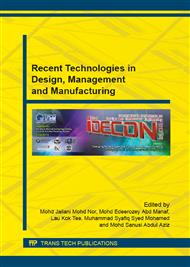[1]
O. Ozturk, B. Uludag, A. Usumez, V. Sahin, G. Celik, The effect of ceramic thickness and number of firings on the color of two all-ceramic systems, J. Prosthet. Dent. 100 (2008), 99-106.
DOI: 10.1016/s0022-3913(08)60156-0
Google Scholar
[2]
K.T.L. Barizon, C. Bergeron, M.A. Vargas, F. Qian, D.S. Cobb, D.G. Gratton, S. Geraldeli, Ceramic materials for porcelain veneers. Part I: Correlation between translucency parameters and contrast ratio, J. Prosthet. Dent. 110 (2013), 397-401.
DOI: 10.1016/j.prosdent.2013.06.008
Google Scholar
[3]
H.Y. Cho, H.Y. Won, H.C. Choe, M.K. Son, Fracture Characteristics of Dental Ceramic Crown according to Zirconia Coping Design, Procedia Eng. 10 (2011), 1561-1566.
DOI: 10.1016/j.proeng.2011.04.261
Google Scholar
[4]
E. Tsalouchou, M.J. Cattell, J.C. Knowles, P. Pittayachawan, A. McDonald, Fatigue and fracture properties of yttria partially stabilized zirconia crown systems, Dent. Mater. 24 (2008), 308-318.
DOI: 10.1016/j.dental.2007.05.011
Google Scholar
[5]
P.E. Spyropoulou, E.C. Giroux, M.E. Razzoog, R.E. Duff, Translucency of shaded zirconia core material, J. Prosthet. Dent. 105 (2011), 304-307.
DOI: 10.1016/s0022-3913(11)60056-5
Google Scholar
[6]
J.R. Kelly, I. Nishimura, S.D. Campbell, Ceramics in dentistry: Historical roots and current perspectives, J. Prosthet. Dent. 75 (1996), 18-32.
DOI: 10.1016/s0022-3913(96)90413-8
Google Scholar
[7]
P.F. Manicone, I.P. Rossi, L. Raffaelli, An overview of zirconia ceramics: Basic properties and clinical applications, J. Dent. 35 (2007), 819-826.
DOI: 10.1016/j.jdent.2007.07.008
Google Scholar
[8]
C. Persson, E. Unosson, I. Ajaxon, J. Engstrand, H. Engqvist, W. Xia, Nano grain sized zirconia–silica glass ceramics for dental applications, J. Eur. Ceram. Soc. 32 (2012), 4105-4110.
DOI: 10.1016/j.jeurceramsoc.2012.06.028
Google Scholar
[9]
P. Baldissara, A. Llukacej, L. Ciocca, F.L. Valandro, R. Scotti, Translucency of zirconia copings made with different CAD/CAM systems, J. Prosthet. Dent. 104 (2010), 6-12.
DOI: 10.1016/s0022-3913(10)60086-8
Google Scholar
[10]
F. Wang, H. Takahashi, N. Iwasaki, Translucency of dental ceramics with different thicknesses, J. Prosthet. Dent. 110 (2013), 14-20.
Google Scholar
[11]
L. Jiang, Y. Liao, Q. Wan, W. Li, Effects of sintering temperature and particle size on the translucency of zirconium dioxide dental ceramic, J. Mater. Sci.: Mater. Med. 22 (2011), 2429-2435.
DOI: 10.1007/s10856-011-4438-9
Google Scholar
[12]
W. Zhang, T. Lu, N. Wei, Y. Wang, B. Ma, F. Li, Z. Lu, J. Qi, Assessment of light scattering by pores in Nd: YAG transparent ceramics, J. Alloy Comp. d. 520 (2012), 36-41.
DOI: 10.1016/j.jallcom.2011.12.012
Google Scholar
[13]
M.J. Kim, J.S. Ahn, J.H. Kim, H.Y. Kim, W.C. Kim, Effects of the sintering conditions of dental zirconia ceramics on the grain size and translucency, J. Adv. Prosthodont. 5 (2013), 161-166.
DOI: 10.4047/jap.2013.5.2.161
Google Scholar
[14]
S. Ban, Reliability and properties of core materials for all-ceramic dental restorations, Jpn. Dent. Sci. Rev. 44 (2008), 3-21.
Google Scholar
[15]
M.J. Heffernan, S.A. Aquilino, A.M. Diaz-Arnold, D.R. Haselton, C.M. Stanford, M.A. Vargas, Relative translucency of six all-ceramic systems. Part I: Core materials, J. Prosthet. Dent. 88 (2002), 4-9.
DOI: 10.1067/mpr.2002.126794
Google Scholar
[16]
B. Stawarczyk, M. Özcan, L. Hallmann, A. Ender, A. Mehl, C.F. Hämmerlet, The effect of zirconia sintering temperature on flexural strength, grain size, and contrast ratio, Clin. Oral Invest. 17 (2012), 1-6.
DOI: 10.1007/s00784-012-0692-6
Google Scholar
[17]
L. Bergstrom, Colloidal Processing of Ceramics, John Wiley & Sons Ltd, Institute for Surface Chemistry, Stockholm, Sweden, (2001).
Google Scholar
[18]
N.F. Amat, A. Muchtar, M.J. Ghazali, N. Yahaya, Suspension stability and sintering influence on yttria-stabilized zirconia fabricated by colloidal processing, Ceram. Int. 40 (2014), 5413-5419.
DOI: 10.1016/j.ceramint.2013.10.123
Google Scholar


